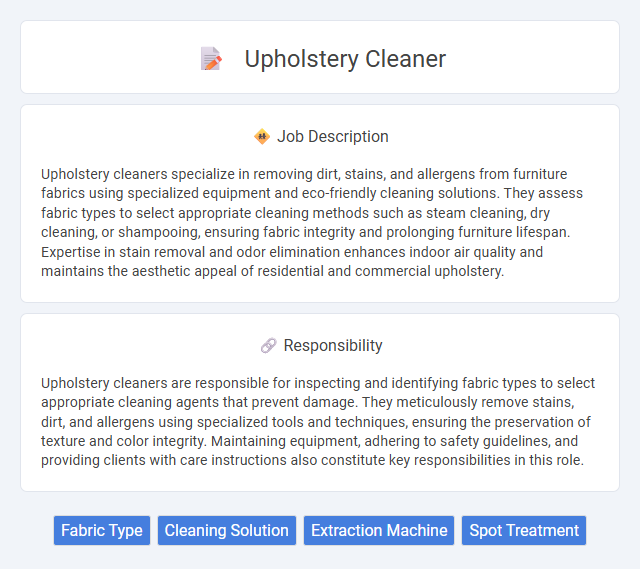
Upholstery cleaners specialize in removing dirt, stains, and allergens from furniture fabrics using specialized equipment and eco-friendly cleaning solutions. They assess fabric types to select appropriate cleaning methods such as steam cleaning, dry cleaning, or shampooing, ensuring fabric integrity and prolonging furniture lifespan. Expertise in stain removal and odor elimination enhances indoor air quality and maintains the aesthetic appeal of residential and commercial upholstery.
Individuals with good physical stamina and attention to detail are likely well-suited for upholstery cleaner jobs due to the manual nature and precision required in removing stains and dirt. Those prone to allergies or respiratory issues might find this role challenging because of exposure to cleaning chemicals and dust particles. The probability of job satisfaction increases if a person enjoys hands-on work and maintaining cleanliness in living or commercial spaces.
Qualification
Upholstery cleaner jobs require proficiency in using specialized cleaning equipment and knowledge of various fabric types to prevent damage. Candidates must have attention to detail and physical stamina to handle deep cleaning tasks and removal of stains from furniture materials. Certification in textile and upholstery cleaning techniques enhances job prospects and ensures adherence to industry standards.
Responsibility
Upholstery cleaners are responsible for inspecting and identifying fabric types to select appropriate cleaning agents that prevent damage. They meticulously remove stains, dirt, and allergens using specialized tools and techniques, ensuring the preservation of texture and color integrity. Maintaining equipment, adhering to safety guidelines, and providing clients with care instructions also constitute key responsibilities in this role.
Benefit
Using an upholstery cleaner likely enhances the longevity and appearance of furniture by effectively removing dirt, stains, and allergens embedded in fabric. This process probably improves indoor air quality and creates a healthier living environment. Regular cleaning may also prevent costly repairs or replacements, making it a cost-efficient maintenance solution.
Challenge
Upholstery cleaning likely presents the challenge of removing stubborn stains and embedded dirt without damaging delicate fabrics. Technicians may encounter difficulty in selecting appropriate cleaning agents that balance effectiveness with fabric safety. Maintaining equipment and adapting to various upholstery materials might require continuous learning and attention to detail.
Career Advancement
Upholstery cleaner roles offer significant opportunities for career advancement through specialized training in fabric care techniques and stain removal technologies. Professionals can progress by gaining certifications in textile cleaning standards, leading to supervisory positions or roles in commercial and industrial cleaning sectors. Mastery of eco-friendly cleaning solutions and customer service excellence further enhances prospects for higher-paying managerial roles or independent business ventures.
Key Terms
Fabric Type
Experts in upholstery cleaning specialize in treating a variety of fabric types, including cotton, polyester, velvet, microfiber, and leather. Professional upholstery cleaners use tailored techniques and eco-friendly solutions to remove stains, dirt, and allergens without damaging delicate fibers. Understanding the specific fabric type is crucial for selecting the appropriate cleaning method to preserve texture, color, and durability.
Cleaning Solution
Upholstery cleaner jobs require expertise in selecting and applying specialized cleaning solutions designed to break down dirt, stains, and allergens embedded in fabrics. These solutions often contain a blend of surfactants, enzymes, and solvents that ensure effective removal of contaminants without damaging delicate upholstery materials. Proper knowledge of cleaning solution composition and compatibility with various fabric types enhances cleaning efficiency and prolongs upholstery lifespan.
Extraction Machine
Extraction machines are essential tools in upholstery cleaning, utilizing powerful suction and hot water to remove dirt, stains, and allergens from fabric surfaces. These machines improve cleaning efficiency by penetrating deep into upholstery fibers, restoring appearance and extending the life of furniture. Mastery of extraction machine operation is crucial for professional upholstery cleaners aiming to deliver thorough, hygienic results.
Spot Treatment
Spot treatment in upholstery cleaning involves targeted removal of stains using specialized solvents and techniques tailored to fabric types. Effective spot treatment preserves the upholstery's appearance and extends its lifespan by addressing spills, pet stains, and accidental marks quickly. Professional upholstery cleaners utilize eco-friendly and non-toxic products ensuring deep stain extraction without damaging delicate fibers.
 kuljobs.com
kuljobs.com